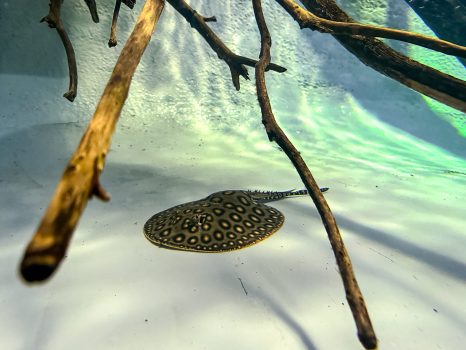Motoro Stingray
Common Name: Motoro Stingray
Scientific Name: Potamotrygon motoro
Names: N/A
Locations: London


Diet
Motoro Stingrays are carnivorous, feeding on a diet consisting of small fish, crustaceans, worms, and other invertebrates found on the riverbed.
Average lifespan
In the wild, Motoro Stingrays can live around 10 to 15 years, though they may live longer in captivity with proper care.
Size
Motoro Stingrays can reach a disc width of up to 50 centimeters (20 inches) on average, though some individuals may grow larger.
Weight
Adult Motoro Stingrays can weigh between 10 to 15 kilograms (22 to 33 pounds), depending on their size and age.
About
Motoro Stingrays are native to the freshwater river systems of South America, particularly the Amazon Basin, the Orinoco Basin, and various rivers in Argentina, Paraguay, and Uruguay. They inhabit slow-moving waters with sandy or muddy bottoms where they can easily find food.
Size and behavior
Motoro Stingrays have a circular, flattened body with a long tail equipped with one or more venomous spines used for defense. They are bottom-dwellers, spending most of their time buried in the substrate or gliding along the riverbed in search of food. They are generally solitary but can be found in groups during the breeding season.
Diet and nutrition
In the wild, Motoro Stingrays use their keen sense of smell and electroreception to locate prey hidden in the substrate. They consume a variety of invertebrates and small fish. In captivity, they can be fed a diet of live or frozen foods such as shrimp, fish fillets, earthworms, and commercial stingray pellets to ensure they receive the necessary nutrients.
Conservation status
The conservation status of the Motoro Stingray is not well-documented, but they are generally not considered to be at high risk. However, they may face localized threats from habitat destruction, water pollution, and overfishing in some parts of their range. Efforts to preserve their natural habitats and regulate fishing practices are important for their long-term conservation.
Fun fact
Motoro Stingrays have a unique ability to detect electrical signals produced by the muscles and nerves of their prey. This electroreception ability helps them locate food hidden in the substrate, making them efficient hunters even in murky waters where visibility is low.
Call or visit your local Reptilia Facility to learn how you can adopt one of these amazing reptiles.








